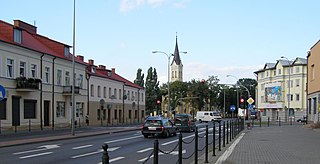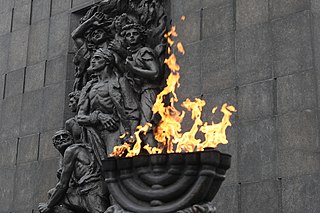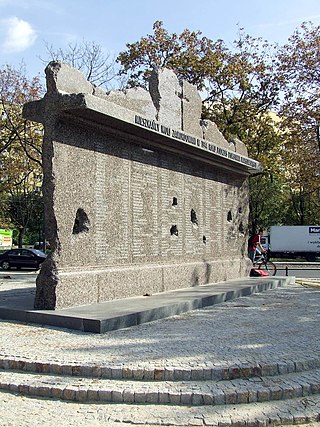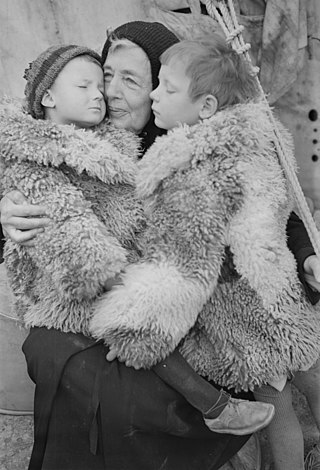Related Research Articles

Grajewo is a town in north-eastern Poland with 21,499 inhabitants (2016). It is the capital of Grajewo County within the Podlaskie Voivodeship. It is located within the historic region of Masovia, near the border with Podlachia and Masuria.

The history of the Jews in Poland dates back at least 1,000 years. For centuries, Poland was home to the largest and most significant Ashkenazi Jewish community in the world. Poland was a principal center of Jewish culture, because of the long period of statutory religious tolerance and social autonomy which ended after the Partitions of Poland in the 18th century. During World War II there was a nearly complete genocidal destruction of the Polish Jewish community by Nazi Germany and its collaborators of various nationalities, during the German occupation of Poland between 1939 and 1945, called the Holocaust. Since the fall of communism in Poland, there has been a renewed interest in Jewish culture, featuring an annual Jewish Culture Festival, new study programs at Polish secondary schools and universities, and the opening of Warsaw's Museum of the History of Polish Jews.

Kovel is a city in Volyn Oblast, northwestern Ukraine. It serves as the administrative center of Kovel Raion within the oblast. Population: 67,575.

The Polish diaspora comprises Poles and people of Polish heritage or origin who live outside Poland. The Polish diaspora is also known in modern Polish as Polonia, the name for Poland in Latin and many Romance languages.

Legnickie Pole is a village in Legnica County, Lower Silesian Voivodeship, in south-western Poland. It is the seat of the administrative district (gmina) called Gmina Legnickie Pole.

During the Second World War (1939–1945), India was a part of the British Empire. British India officially declared war on Nazi Germany in September 1939. India, as a part of the Allied Nations, sent over two and a half million soldiers to fight under British command against the Axis powers. India was also used as the base for American operations in support of China in the China Burma India Theater.

Shahu of the Bhonsle dynasty of Marathas was a Raja and the first Maharaja (1900–1922) of the Indian princely state of Kolhapur. Rajarshi Shahu was considered a true democrat and social reformer. Shahu Maharaj was an able ruler who was associated with many progressive policies during his rule. From his coronation in 1894 till his demise in 1922, he worked for the cause of the lower caste subjects in his state. Primary education to all regardless of caste and creed was one of his most significant priorities.

Crimes against the Polish nation committed by Nazi Germany and Axis collaborationist forces during the invasion of Poland, along with auxiliary battalions during the subsequent occupation of Poland in World War II, included the genocide of millions of Polish people, especially the systematic extermination of Jewish Poles. These mass killings were enacted by the Nazis with further plans that were justified by their racial theories, which regarded Poles and other Slavs, and especially Jews, as racially inferior Untermenschen.

Wojtek (1942 – 2 December 1963; Polish pronunciation:[ˈvɔjtɛk]; in English, sometimes phonetically spelled Voytek was a Syrian brown bear bought, as a young cub, in the mountains of Iran, by Polish II Corps soldiers who had been evacuated from the Soviet Union. In order to provide for his rations and transportation, he was eventually enlisted officially as a soldier with the rank of private, and was subsequently promoted to corporal.

The Polish Air Force Memorial is a war memorial in West London, England in memory of airmen from Poland who served in the Royal Air Force as part of the Polish contribution to World War II. Over 18,000 men and women served in the Polish squadrons of the RAF during the war, and over 2,000 died. The memorial marks the southern extremity of South Ruislip in the London Borough of Hillingdon, near RAF Northolt, where seven Polish-manned fighter squadrons were based at different times in the war.

Sir Digvijaysinhji Ranjitsinhji Jadeja was the Maharaja Jam Sahib of Nawanagar from 1933 to 1966, succeeding his uncle, the famed cricketer Ranjitsinhji.

Polish–Romanian relations are foreign relations between Poland and Romania.

Indo-Polish relations are the bilateral relations between the Republic of Poland and the Republic of India. Historically, relations have generally been friendly, characterised by understanding and cooperation on an international front.

Polish Jews were the primary victims of the Nazi Germany-organized Holocaust in Poland. Throughout the German occupation of Poland, Jews were rescued from the Holocaust by Polish people, at risk to their lives and the lives of their families. According to Yad Vashem, Israel's official memorial to the victims of the Holocaust, Poles were, by nationality, the most numerous persons identified as rescuing Jews during the Holocaust. By January 2022, 7,232 people in Poland have been recognized by the State of Israel as Righteous among the Nations.

Following the Soviet invasion of Poland at the onset of World War II, in accordance with the Nazi-Soviet Pact against Poland, the Soviet Union acquired more than half of the territory of the Second Polish Republic or about 201,000 square kilometres (78,000 sq mi) inhabited by more than 13,200,000 people. Within months, in order to de-Polonize annexed lands, the Soviet NKVD rounded up and deported between 320,000 and 1 million Polish nationals to the eastern parts of the USSR, the Urals, and Siberia. There were four waves of deportations of entire families with children, women, and elderly people aboard freight trains from 1940 until 1941. The second wave of deportations by the Soviet occupational forces across the Kresy macroregion, affected 300,000 to 330,000 Poles, sent primarily to Kazakhstan.
The following is a timeline of the history of the city of Białystok, Poland.
Balachadi is a village in Jodiya Taluka of Jamnagar district, Gujarat, India. It is 25 kilometres east of Jamnagar, near the Gulf of Kutch.
Kira Banasińska (1899-2002) was the wife of Eugeniusz Banasiński, the first Polish Consul-General of Poland in Bombay. She was a representative of the Polish Red Cross in India. Kira cared for and helped in rehabilitating the lives of several thousand Polish children, women and old people who were refugees from Russia, who were accommodated during World War II with local help in India.

The Mausoleum of the Martyrdom of Polish Villages in Michniów is a museum located in Michniów, in Świętokrzyskie Voivodeship, in Poland, constituting a branch of the Museum of the Kielce Village, commemorating the pacification actions in German-occupied Poland.
References
- 1 2 "Polish WW-II Memorial Pillar unveiled in Kolhapur". Outlook India. 14 September 2019. Retrieved 14 September 2019.
- ↑ Bhusari, Piyush (12 September 2019). "Memorial pillar to remember Polish refugees to be unveiled on Saturday". The Times of India. Retrieved 14 September 2019.
- ↑ Banerjee, Shoumojit (14 September 2019). "Memorial to Polish refugees to be unveiled in Kolhapur". The Hindu. ISSN 0971-751X . Retrieved 14 September 2019.
- ↑ Phadke, Manasi (14 September 2019). "For these Poland nationals with ties to World War II, 'home' is a tiny village in Maharashtra". The Print. Retrieved 14 September 2019.
- ↑ Piotrowski, Tadeusz (17 September 2015). The Polish Deportees of World War II: Recollections of Removal to the Soviet Union and Dispersal Throughout the World. McFarland. ISBN 978-0-7864-5536-2.
- ↑ Phadnis, Samrat (13 February 2014). "Over 70 Polish refugees to visit city in March, relive WW-II memories". The Times of India. Archived from the original on 2 February 2020.
- ↑ Deshpande, Devidas (31 July 2011). "The last Pole of Valivade". Pune Mirror. Archived from the original on 20 October 2019.
- ↑ Wójcicka, Ewa. "Google Arts & Culture: 1939–1948 Passage to India, Polish settlements in Balachadi and Valivade". Warsaw: Polish History Museum.
- ↑ Jumde, Anandita (17 April 2016). "How One Maharaja Helped Save the Lives of 640 Polish Children and Women During World War II". Bangalore: The Better India, Vikara Media Pvt Ltd.